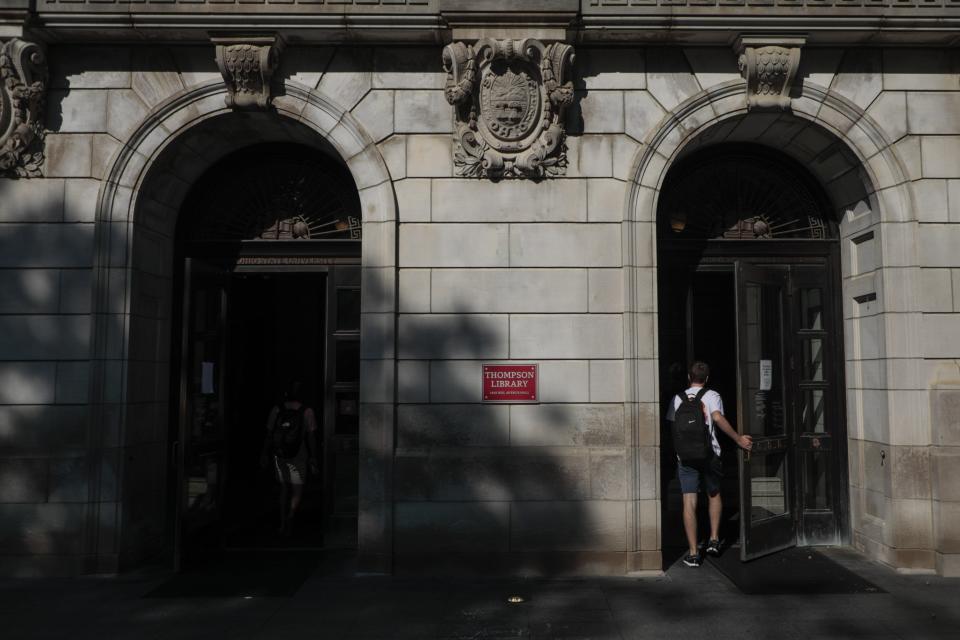Ohio State trustees approve 4.6% increases in tuition and room & board for incoming freshmen
Ohio State University's board of trustees unanimously voted to increase tuition and fees for new, in-state students Thursday by 4.6%, amounting to an additional $549 annually..
The change will bring the total cost per year for new undergraduates to attend the university to $12,485, which will remain frozen for the next four years.
Returning undergraduate students from Ohio will pay the same amount as they did last year due to the university’s participation in the Ohio State Tuition Guarantee program. Since 2018, incoming freshmen classes have been included in the program, which essentially sets in-state tuition costs for each class and freezes those rates for four years.
Out-of-state students will see a 5% surcharge increase in their tuition costs on top of the 4.6% hike for all freshmen. They will now pay $35,019 annually, $2,252 more than last year.
The surcharge for international students will remain the same as last year, which now at $39,650 per year.
Tuition: More than 700 for free Columbus State tuition, path to Ohio State
Ohio State athletics: Ohio State to begin paying academic bonuses to athletes this fall
Education in Ohio: From $2,000 grants to free speech: Ohio passes sweeping higher education reform bill
Students at all Ohio State’s regional campuses will face the same percentage changes in their tuition and fees. In Lima, Mansfield, Marion and Newark, Ohioans will now be charged $8,944 per year, and out-of-state students will pay $24,237. At the Agricultural Technical Institute in Wooster, the costs will be $8,900 for in-state students and $33,137 for those coming from other states.
Trustees also approved a 4.6% increase for new students in both their dining and housing costs. The former will go up $196 to $4,452 and the latter will rise $418 to $9,514. These amounts also will remain the same for students throughout their time at the university due to the Ohio State Tuition Guarantee program.
For Ohio residents, the university is now the seventh-most-affordable university among Big Ten schools, the same as last fiscal year. For nonresidents, the changes have moved Ohio State from the seventh to eighth-most-affordable among these schools.
Ohio State hikes tuition in the face of financial challenges
The university has decided to raise this year’s tuition costs due to a variety of reasons, according to Michael Papadakis, OSU's senior vice president of business and finance and chief financial officer.
For one, Ohio State’s tuition freeze from 2014 to 2017 — as well as its enrollment in the Ohio State Tuition Guarantee program the following year — has caused some financial strain on the university’s operations, he said.
State funding has not kept up with inflation either, according to Papadakis. In fiscal year 2021, for example, the university got the same amount of state dollars as it did back in 2009.
“There's significant inflationary impacts we're seeing both from a labor standpoint — that's full-time employees and student employees as well — and then all of the commodity cost pressures that we're all seeing, whether it's energy costs, food costs, etc.,” Papadakis said during the Audit, Finance and Investment Committee meeting Thursday. “We are feeling all of those obviously as an institution.”

Ohio State: Ohio State president touts 'big wins' during State of the University address
Gov. Mike DeWine, however, took issue with the increases in a statement.
"Ohio families are suffering from significant cost increases due to inflation, and this is not the time for college costs to increase by $549 for those families with incoming first-year students," he said. "I am disappointed that Ohio State is raising tuition on incoming first-year students. This is not a wise decision."
Papadakis highlighted the university’s growing commitment to financial aid and scholarship programs.
Ohio State is in the middle of a campaign to spend $305 million offering additional need-based financial aid to 45,000 students from 2015 through 2023, he said. The new Scarlet and Gray Advantage Program, which aims to offer debt-free bachelor's degrees to undergraduates, will also launch this fall with a pilot group of 125 students.
Undergraduate Student Government President Andrew Pierce said he understands the tuition increases serve as a response to a host of financial challenges the university faces, primarily driven by the rising rate of inflation.
“This will have varied impacts across the student body,” Pierce said in an email statement. “For the incoming freshman class, it will impact the finances needed to attend Ohio State and require deeper conversations about the rising cost of higher education.”
Pierce added that the undergraduate student government plans to donate funds to Ohio State’s scholarship programs so that students will not have to face lifelong debt to achieve academic success.
Board approves new campus investment plans
The OSU board of trustees also approved new investments in infrastructure projects, academic programs and public safety.
Three months ago, university trustees authorized spending $1.2 million to update Ohio State’s campus master plan to continue investment in ongoing projects and come up with ways of improving student housing, dining, recreation and support services.

On Thursday, the board approved the new master plan — now known as “Framework 3.0" — for 2023 to 2027.
With a total projected expenditure of about $2.4 billion over the next five years, these projects, most of them already underway, include the expansion of the university’s arts district, the development of new medical facilities and the construction of a new outdoor lacrosse stadium.
Ohio State: Ohio State trustees discuss NIL deals, approve $1.2 million for new university master plan
On the academic side, the financial plan included a package of about $52 million allocated toward hiring about 120 faculty members in the next fiscal year — which is expected to net 10 to 20 new faculty following anticipated turnover — in order to meet the university’s goal of increasing its tenure-track faculty by 350 over the next decade.
Moreover, $18.6 million will be spent toward meeting Ohio State’s goal of doubling its research expenditures in the next 10 years.
Trustees also approved $5.5 million for additional public safety efforts at Ohio State. The number of major on-campus crimes surged from a total 69 in the previous fiscal year to 174 so far in this fiscal year. The staff has also observed a rise in the number of crimes that involve a gun, according to Jay Kasey, Ohio State’s senior vice president of administration and planning.
“It worries us greatly,” Kasey said during the trustees' Master Planning and Facilities Committee meeting. “And we're working with the Columbus Division of Police to try to make sure that we manage that, and try to keep guns out of the hands of those who shouldn't have it.”
Yilun Cheng is a Report for America corps member and covers immigration issues for the Dispatch. Your donation to match our RFA grant helps keep her writing stories like this one. Please consider making a tax-deductible donation at https://bit.ly/3fNsGaZ.
ycheng@dispatch.com
@ChengYilun
This article originally appeared on The Columbus Dispatch: Ohio State University increases tuition, fees for new students

